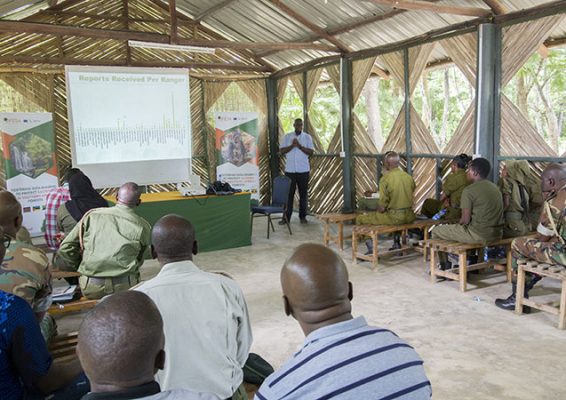
Fatuma Mansur is a forest ranger in Kilifi County, Eastern Kenya. The area is home to the largest remaining fragment of intact coastal forest in East Africa. Called Arabuko Sokoke, it was declared a world biosphere reserve by UNESCO in 2019. It contains three types of forest and is home to savannah elephants, baboons, and a number of charismatic endemic animals, including the endearingly-odd golden-rumped elephant shrew [Rhynchocyon chrysopygus]. It’s also a significant carbon sink for the region, which matters all the more since Kenya has committed to reducing its anthropogenic carbon emissions by 32 percent on business-as-usual by 2030 as part of its Nationally-Determined Contributions (NDCs) to the Paris Agreement on climate change.
But making sure that forests like Arabuko Sukoke aren’t being exploited through practices like illegal timber harvesting and poaching has always been a challenge. They cover huge areas – this one around 41,600 hectares – and until recently, monitoring technology and capacity has not been up to the task. These days, countries need to keep a particularly keen eye on what’s happening in their forests, in order to fulfil monitoring requirements for restoration and climate mitigation targets such as the Africa-wide restoration initiative AFR100 and the global Paris Agreement.
The East and Southern Africa Forest Observatory (OFESA) was launched at the Global Landscapes Forum (GLF)’s Nairobi conference in late 2018 to help countries in the region to develop up-to-date and reliable national inventories through which to monitor and report on their climate mitigation commitment obligations. It’s jointly led by the Centre for International Forestry Research and World Agroforestry (CIFOR-ICRAF) and the Regional Centre for Mapping of Resources for Development (RCMRD), with funding from the European Union. Its work is centred on the notion that with better, more regular, and systematic information on forest trends and threats, countries can meet reporting requirements more easily – and, people can make better decisions at local, national, and regional levels to protect and restore the continent’s critically-important forests and trees.
OFESA has also successfully fostered learning among the countries’ forestry agencies. For instance, Uganda’s forest and wildlife agencies took part in a learning and exchange forum on the forest monitoring system used by rangers and community members. The project has also been upskilling government agencies in data collection, analysis and reporting to assist with the production of national inventories. So far, 103 participants from 20 agencies across Uganda, Kenya, Tanzania, Ethiopia and Mozambique have been trained in current forest monitoring technologies.
“The training focused on the use of technology such as remote sensing, Google Earth Engine, forest carbon estimation, and hotspot mapping,” said Shani Kiluvia, a forestry officer for the Tanzania Forest Service (TFS) who took part in one of these capacity-building events. “All that we’ve been doing in forest management and conservation will now be enhanced. The maps that we are now going to generate will be accurate to a higher degree.”
Looking forward, OFESA is working with participating countries and the EU to develop a synthesis report on the State of Forests in Eastern Africa, updating the geoportal, and developing a governance framework for long-term service of the observatory. “Ultimately, we hope that the capacity that has been enhanced – both at the local level to communities and forest rangers, and also at the national level with officials – will assist these stakeholders to see how they are doing and how they are meeting their national-level targets, and in the long term, contribute to the sustainability of forests in Eastern and Southern Africa,” said Douglas Ombogoh, a research officer at CIFOR-ICRAF who is based in Nairobi and plays a central role in coordinating and managing the project.
We want you to share Forests News content, which is licensed under Creative Commons Attribution-NonCommercial-ShareAlike 4.0 International (CC BY-NC-SA 4.0). This means you are free to redistribute our material for non-commercial purposes. All we ask is that you give Forests News appropriate credit and link to the original Forests News content, indicate if changes were made, and distribute your contributions under the same Creative Commons license. You must notify Forests News if you repost, reprint or reuse our materials by contacting forestsnews@cifor-icraf.org.

